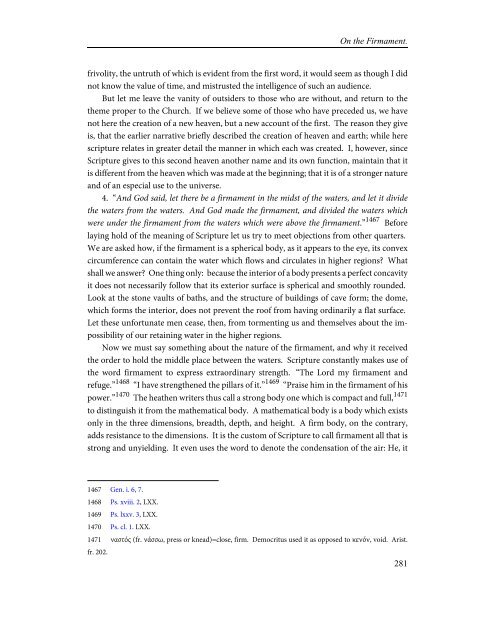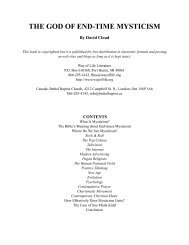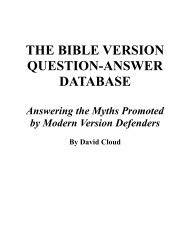- Page 2 and 3:
NPNF2-08. Basil: Letters and Select
- Page 4 and 5:
Writings Mentioned, But Lost.Additi
- Page 7 and 8:
To the Church of Ancyra. Consolator
- Page 9 and 10:
To the Patrician Cæsaria, concerni
- Page 11 and 12:
To the Presbyter Evagrius.To Amioch
- Page 13 and 14:
To the Beræans.To the Beræans.To
- Page 15 and 16:
To Modestus the Prefect.To a bishop
- Page 17 and 18:
Basil to Libanius.Libanius to Basil
- Page 19 and 20:
Title Page.A SELECT LIBRARYOF THENI
- Page 21 and 22:
Preface.Preface.——————
- Page 23 and 24:
Chronological Table.CHRONOLOGICAL T
- Page 25 and 26:
Chronological Table.Synod of Illyri
- Page 27 and 28:
Parentage and Birth.Christian woman
- Page 29 and 30:
Education.II.—Education.The place
- Page 31 and 32:
Education.There is no corroboration
- Page 33 and 34:
Education.decline, and comes away v
- Page 35 and 36:
Life at Cæsarea; Baptism; and Adop
- Page 37 and 38:
Life at Cæsarea; Baptism; and Adop
- Page 39 and 40:
Basil and the Councils, to the Acce
- Page 41 and 42:
Basil and the Councils, to the Acce
- Page 43 and 44:
The Presbyterate.Pontic monasteries
- Page 45 and 46:
The Presbyterate.province, each und
- Page 47 and 48:
Basil as Archbishop.of Basil. It wa
- Page 49 and 50:
Basil as Archbishop.imity, if not o
- Page 51 and 52:
Basil as Archbishop.had no terrors
- Page 53 and 54:
Basil as Archbishop.Nevertheless, s
- Page 55 and 56:
The Breach with Gregory of Nazianzu
- Page 57 and 58:
The Breach with Gregory of Nazianzu
- Page 59 and 60:
St. Basil and Eustathius.VIII.—St
- Page 61 and 62:
Unbroken Friendships.IX.—Unbroken
- Page 63 and 64:
Unbroken Friendships.Glycerius shou
- Page 65 and 66:
Troubles of the Closing Years.X.—
- Page 67 and 68:
Troubles of the Closing Years.It is
- Page 69 and 70:
Troubles of the Closing Years.evoke
- Page 71 and 72:
Works.II. Works.The extant works of
- Page 73 and 74:
Dogmatic.The accession of Julian br
- Page 75 and 76:
Dogmatic.and that heresy is the exp
- Page 77 and 78:
Dogmatic.Son, no other word would h
- Page 79 and 80:
Dogmatic.be observed in the meaning
- Page 81 and 82:
Dogmatic.“If the Son is subjected
- Page 83 and 84:
Dogmatic.He Who had raised Lazarus
- Page 85 and 86:
Dogmatic.On Mark x. 18. There is no
- Page 87 and 88:
Dogmatic.called her first born. For
- Page 89 and 90:
Dogmatic.my salvation,’ 433 and s
- Page 91 and 92:
Dogmatic.“If the Son has not auth
- Page 93 and 94:
Dogmatic.work of St. Ambrose, compo
- Page 95 and 96:
Exegetic.Homily on Psalm i. begins
- Page 97 and 98:
Exegetic.with us through the street
- Page 99 and 100:
Exegetic.whereof the Apostle says,
- Page 101 and 102:
Exegetic.other men’s springs; pro
- Page 103 and 104:
Exegetic.(iii.) The Commentary on I
- Page 105 and 106:
Ascetic.III.—Ascetic.(i) Of the w
- Page 107 and 108:
Ascetic.and about Him, according to
- Page 109 and 110:
Ascetic.Children are not to be rece
- Page 111 and 112:
Ascetic.of Paul and Silas, 558 and
- Page 113 and 114:
Ascetic.to be pledged to join the c
- Page 115 and 116:
Homiletical.aversion from what is i
- Page 117 and 118:
Homiletical.art thou distressed? Wh
- Page 119 and 120:
Homiletical.of qualities. By adopti
- Page 121 and 122:
Homiletical.it is of no small impor
- Page 123 and 124:
Homiletical.that the phrase has mor
- Page 125 and 126:
Homiletical.nothing to divide nor t
- Page 127 and 128:
Homiletical.themselves be comforted
- Page 129 and 130:
Homiletical.lion hath roared: who w
- Page 131 and 132:
Homiletical.crowd of lads to stare
- Page 133 and 134:
Homiletical.fleeing from the sirens
- Page 135 and 136:
Homiletical.confirms in act the phi
- Page 137 and 138:
Homiletical.cration 677 practices t
- Page 139 and 140:
Homiletical.The homily, which recom
- Page 141 and 142:
Homiletical.God in whom I have trus
- Page 143 and 144:
Homiletical.The last of the Panegyr
- Page 145 and 146:
Liturgical.VI.—Liturgical.It is b
- Page 147 and 148:
Writings Mentioned, But Lost.VIII.
- Page 149 and 150:
Additional Notes on Some Points in
- Page 151 and 152:
Editions and Manuscripts.E. Fialon,
- Page 153 and 154:
Editions and Manuscripts.Ult. est a
- Page 155 and 156:
Editions and Manuscripts.23771. c.
- Page 157 and 158:
Preface.sion of Constantinople. It
- Page 159 and 160:
Prefatory remarks on the need of ex
- Page 161 and 162:
The origin of the heretics' close o
- Page 163 and 164:
The systematic discussion of syllab
- Page 165 and 166:
That there is no distinction in the
- Page 167 and 168:
That v: not found “of whom” in
- Page 169 and 170:
That v: not found “of whom” in
- Page 171 and 172:
That v: not found “of whom” in
- Page 173 and 174:
Issue joined with those who assert
- Page 175 and 176:
Issue joined with those who assert
- Page 177 and 178:
Issue joined with those who assert
- Page 179 and 180:
Against those who assert that it is
- Page 181 and 182:
In how many ways “Through whom”
- Page 183 and 184:
In how many ways “Through whom”
- Page 185 and 186:
In how many ways “Through whom”
- Page 187 and 188:
In how many ways “Through whom”
- Page 189 and 190:
Definitive conceptions about the Sp
- Page 191 and 192:
Definitive conceptions about the Sp
- Page 193 and 194:
Against those who say that it is no
- Page 195 and 196:
That they who deny the Spirit are t
- Page 197 and 198:
Against those who assert that the b
- Page 199 and 200:
Statement of the reason why in the
- Page 201 and 202:
Objection that some were baptized u
- Page 203 and 204:
Objection that some were baptized u
- Page 205 and 206:
Reply to the suggested objection th
- Page 207 and 208:
Reply to the suggested objection th
- Page 209 and 210:
That the Holy Spirit is in every co
- Page 211 and 212:
That the Holy Spirit is in every co
- Page 213 and 214:
That the Holy Spirit is in every co
- Page 215 and 216:
Against those who say that the Holy
- Page 217 and 218:
In what manner in the confession of
- Page 219 and 220:
In what manner in the confession of
- Page 221 and 222:
In what manner in the confession of
- Page 223 and 224:
Against those who assert that the S
- Page 225 and 226:
Against those who assert that the S
- Page 227 and 228:
Against those who maintain that the
- Page 229 and 230:
Proof from Scripture that the Spiri
- Page 231 and 232:
Establishment of the natural commun
- Page 233 and 234:
The glorifying of the enumeration o
- Page 235 and 236:
Proof of the absurdity of the refus
- Page 237 and 238:
Proof of the absurdity of the refus
- Page 239 and 240:
That Scripture uses the words “in
- Page 241 and 242:
That the word “in,” in as many
- Page 243 and 244:
That the word “in,” in as many
- Page 245 and 246:
That the word “in,” in as many
- Page 247 and 248: Of the origin of the word “with,
- Page 249 and 250: Of the origin of the word “with,
- Page 251 and 252: Of the origin of the word “with,
- Page 253 and 254: Of the origin of the word “with,
- Page 255 and 256: That our opponents refuse to conced
- Page 257 and 258: Enumeration of the illustrious men
- Page 259 and 260: Enumeration of the illustrious men
- Page 261 and 262: Enumeration of the illustrious men
- Page 263 and 264: Enumeration of the illustrious men
- Page 265 and 266: Exposition of the present state of
- Page 267 and 268: Exposition of the present state of
- Page 269 and 270: The Hexæmeron.Introduction to the
- Page 271 and 272: In the Beginning God made the Heave
- Page 273 and 274: In the Beginning God made the Heave
- Page 275 and 276: In the Beginning God made the Heave
- Page 277 and 278: In the Beginning God made the Heave
- Page 279 and 280: In the Beginning God made the Heave
- Page 281 and 282: In the Beginning God made the Heave
- Page 283 and 284: “The Earth was Invisible and Unfi
- Page 285 and 286: “The Earth was Invisible and Unfi
- Page 287 and 288: “The Earth was Invisible and Unfi
- Page 289 and 290: “The Earth was Invisible and Unfi
- Page 291 and 292: “The Earth was Invisible and Unfi
- Page 293 and 294: “The Earth was Invisible and Unfi
- Page 295 and 296: “The Earth was Invisible and Unfi
- Page 297: On the Firmament.the thought hidden
- Page 301 and 302: On the Firmament.be a firmament.”
- Page 303 and 304: On the Firmament.others into inacce
- Page 305 and 306: On the Firmament.8. “And God call
- Page 307 and 308: On the Firmament.thus dew, the fros
- Page 309 and 310: Upon the gathering together of the
- Page 311 and 312: Upon the gathering together of the
- Page 313 and 314: Upon the gathering together of the
- Page 315 and 316: Upon the gathering together of the
- Page 317 and 318: The Germination of the Earth.How th
- Page 319 and 320: The Germination of the Earth.nothin
- Page 321 and 322: The Germination of the Earth.the ro
- Page 323 and 324: The Germination of the Earth.that t
- Page 325 and 326: The Germination of the Earth.some t
- Page 327 and 328: The creation of luminous bodies.ent
- Page 329 and 330: The creation of luminous bodies.of
- Page 331 and 332: The creation of luminous bodies.abl
- Page 333 and 334: The creation of luminous bodies.or
- Page 335 and 336: The creation of luminous bodies.day
- Page 337 and 338: The creation of luminous bodies.can
- Page 339 and 340: The creation of luminous bodies.now
- Page 341 and 342: The creation of moving creatures.Ho
- Page 343 and 344: The creation of moving creatures.of
- Page 345 and 346: The creation of moving creatures.be
- Page 347 and 348: The creation of moving creatures.sa
- Page 349 and 350:
The creation of moving creatures.th
- Page 351 and 352:
The creation of fowl and water anim
- Page 353 and 354:
The creation of fowl and water anim
- Page 355 and 356:
The creation of fowl and water anim
- Page 357 and 358:
The creation of fowl and water anim
- Page 359 and 360:
The creation of fowl and water anim
- Page 361 and 362:
The creation of fowl and water anim
- Page 363 and 364:
The creation of terrestrial animals
- Page 365 and 366:
The creation of terrestrial animals
- Page 367 and 368:
The creation of terrestrial animals
- Page 369 and 370:
The creation of terrestrial animals
- Page 371 and 372:
The creation of terrestrial animals
- Page 373 and 374:
The creation of terrestrial animals
- Page 375 and 376:
To Eustathius the Philosopher.Lette
- Page 377 and 378:
Basil to Gregory.Letter II. 1743Bas
- Page 379 and 380:
Basil to Gregory.sessed of self-com
- Page 381 and 382:
Basil to Gregory.one may be spent u
- Page 383 and 384:
To Candidianus.doors, and after app
- Page 385 and 386:
To Nectarius.Letter V. 1768To Necta
- Page 387 and 388:
To the wife of Nectarius.Letter VI.
- Page 389 and 390:
To Gregory my friend.Letter VII. 17
- Page 391 and 392:
To the Cæsareans. A defence of his
- Page 393 and 394:
To the Cæsareans. A defence of his
- Page 395 and 396:
To the Cæsareans. A defence of his
- Page 397 and 398:
To the Cæsareans. A defence of his
- Page 399 and 400:
To the Cæsareans. A defence of his
- Page 401 and 402:
To the Cæsareans. A defence of his
- Page 403 and 404:
To the Cæsareans. A defence of his
- Page 405 and 406:
To Maximus the Philosopher.stance,
- Page 407 and 408:
To a widow.Letter X. 1883To a widow
- Page 409 and 410:
To Olympius.Letter XII. 1888To Olym
- Page 411 and 412:
To Gregory his friend.Letter XIV. 1
- Page 413 and 414:
To Arcadius, Imperial Treasurer.To
- Page 415 and 416:
To Origenes.Letter XVII. 1903To Ori
- Page 417 and 418:
To Gregory my friend.Letter XIX. 19
- Page 419 and 420:
To Leontius the Sophist.Letter XXI.
- Page 421 and 422:
Without address. On the Perfection
- Page 423 and 424:
Without address. On the Perfection
- Page 425 and 426:
To a Solitary.Letter XXIII. 1977To
- Page 427 and 428:
To Athanasius, bishop of Ancyra.To
- Page 429 and 430:
To Cæsarius, brother of Gregory.To
- Page 431 and 432:
To the Church of Neocæsarea. Conso
- Page 433 and 434:
To the Church of Neocæsarea. Conso
- Page 435 and 436:
To Eusebius of Samosata.Letter XXX.
- Page 437 and 438:
To Sophronius the Master.Letter XXX
- Page 439 and 440:
To Aburgius.Letter XXXIII. 2013To A
- Page 441 and 442:
Without address.Letter XXXV. 2018Wi
- Page 443 and 444:
Without address.Letter XXXVII. 2020
- Page 445 and 446:
To his Brother Gregory, concerning
- Page 447 and 448:
To his Brother Gregory, concerning
- Page 449 and 450:
To his Brother Gregory, concerning
- Page 451 and 452:
To his Brother Gregory, concerning
- Page 453 and 454:
Julian to Basil.Letter XL. 2053Juli
- Page 455 and 456:
Basil to Julian.to God. No one will
- Page 457 and 458:
To Chilo, his disciple.shall live.
- Page 459 and 460:
To Chilo, his disciple.life. Above
- Page 461 and 462:
To Chilo, his disciple.chaste, who
- Page 463 and 464:
To a lapsed Monk.Letter XLIV. 2092T
- Page 465 and 466:
To a lapsed Monk.Letter XLV. 2102To
- Page 467 and 468:
To a fallen virgin.Letter XLVI. 210
- Page 469 and 470:
To a fallen virgin.honourable treas
- Page 471 and 472:
To a fallen virgin.hand upon him, h
- Page 473 and 474:
To a fallen virgin.by repentance, w
- Page 475 and 476:
To Gregory.at such a crisis, as I r
- Page 477 and 478:
To Eusebius, Bishop of Samosata.sou
- Page 479 and 480:
To Bishop Innocentius.Letter L. 217
- Page 481 and 482:
To Bishop Bosporius.majesty of deme
- Page 483 and 484:
To the Canonicæ.For they maintaine
- Page 485 and 486:
To the Chorepiscopi.Letter LIII. 21
- Page 487 and 488:
To the Chorepiscopi.Letter LIV. 219
- Page 489 and 490:
To Paregorius, the presbyter.Letter
- Page 491 and 492:
To Meletius, Bishop of Antioch.Lett
- Page 493 and 494:
To Gregory my brother.to me and sha
- Page 495 and 496:
To Gregory, his uncle.I shall be al
- Page 497 and 498:
To Athanasius, Bishop of Alexandria
- Page 499 and 500:
To the Governor of Neocæsarea.Lett
- Page 501 and 502:
To Atarbius.Letter LXV. 2232To Atar
- Page 503 and 504:
To Athanasius, bishop of Alexandria
- Page 505 and 506:
To Athanasius, bishop of Alexandria
- Page 507 and 508:
To Athanasius, bishop of Alexandria
- Page 509 and 510:
To Athanasius, bishop of Alexandria
- Page 511 and 512:
Without address.gloomy and needs mo
- Page 513 and 514:
Basil to Gregory.persuade you to co
- Page 515 and 516:
To Callisthenes.Letter LXXIII. 2259
- Page 517 and 518:
To Martinianus.Letter LXXIV. 2260To
- Page 519 and 520:
To Martinianus.that the evils of Po
- Page 521 and 522:
To Sophronius the Master.Letter LXX
- Page 523 and 524:
Without inscription, on behalf of E
- Page 525 and 526:
To Athanasius, bishop of Alexandria
- Page 527 and 528:
To Bishop Innocent.all who differ f
- Page 529 and 530:
To Athanasius, bishop of Alexandria
- Page 531 and 532:
To the President.Letter LXXXIV. 228
- Page 533 and 534:
That the oath ought not to be taken
- Page 535 and 536:
Without address on the same subject
- Page 537 and 538:
To Meletius, bishop of Antioch.Lett
- Page 539 and 540:
To the holy brethren the bishops of
- Page 541 and 542:
To the Italians and Gauls.Letter XC
- Page 543 and 544:
To the Italians and Gauls.prayers i
- Page 545 and 546:
To Elias, Governor of the Province.
- Page 547 and 548:
To Eusebius, bishop of Samosata.Let
- Page 549 and 550:
To the Senate of Tyana.Letter XCVII
- Page 551 and 552:
To Eusebius, bishop of Samosata.gat
- Page 553 and 554:
To Count Terentius.thanking God for
- Page 555 and 556:
To Eusebius, Bishop of Samosata.Let
- Page 557 and 558:
To the citizens of Satala.Letter CI
- Page 559 and 560:
To the prefect Modestus.Letter CIV.
- Page 561 and 562:
To a soldier.Letter CVI. 2367To a s
- Page 563 and 564:
To the guardian of the heirs of Jul
- Page 565 and 566:
To the prefect Modestus.Letter CX.
- Page 567 and 568:
To Andronicus, a general.Letter CXI
- Page 569 and 570:
To the presbyters of Tarsus.Letter
- Page 571 and 572:
To the heretic Simplicia.Letter CXV
- Page 573 and 574:
To Firminius.Letter CXVI. 2390To Fi
- Page 575 and 576:
To Jovinus, Bishop of Perrha.To Jov
- Page 577 and 578:
To Meletius, bishop of Antioch.Lett
- Page 579 and 580:
To Pœmenius, bishop of Satala.To P
- Page 581 and 582:
To Theodorus.Letter CXXIV. 2406To T
- Page 583 and 584:
A transcript of the faith as dictat
- Page 585 and 586:
A transcript of the faith as dictat
- Page 587 and 588:
To Eusebius, bishop of Samosata.To
- Page 589 and 590:
To Eusebius, bishop of Samosata.app
- Page 591 and 592:
To Meletius Bishop of Antioch.out o
- Page 593 and 594:
To Theodotus bishop of Nicopolis.ne
- Page 595 and 596:
To Olympius.myself more at length o
- Page 597 and 598:
To Peter, bishop of Alexandria.To P
- Page 599 and 600:
To Diodorus, presbyter of Antioch.T
- Page 601 and 602:
To Eusebius, bishop of Samosata.To
- Page 603 and 604:
To Eusebius, bishop of Samosata.To
- Page 605 and 606:
To the Alexandrians.Letter CXXXIX.
- Page 607 and 608:
To the Church of Antioch.Letter CXL
- Page 609 and 610:
To Eusebius, bishop of Samosata.To
- Page 611 and 612:
To the prefects' accountant.Letter
- Page 613 and 614:
To the prefects' officer.Letter CXL
- Page 615 and 616:
To Antiochus.Letter CXLVI. 2481To A
- Page 617 and 618:
To Trajan.Letter CXLVIII. 2486To Tr
- Page 619 and 620:
To Amphilochius in the name of Hera
- Page 621 and 622:
To Amphilochius in the name of Hera
- Page 623 and 624:
To Victor, the Commander.Letter CLI
- Page 625 and 626:
To Ascholius, bishop of Thessalonic
- Page 627 and 628:
To the Presbyter Evagrius.Letter CL
- Page 629 and 630:
To Amiochus.Letter CLVII. 2515To Am
- Page 631 and 632:
To Eupaterius and his daughter.To E
- Page 633 and 634:
To Diodorus.Letter CLX. 2526To Diod
- Page 635 and 636:
To Diodorus.near of kin to him, to
- Page 637 and 638:
To Amphilochius on his consecration
- Page 639 and 640:
To Eusebius, bishop of Samosata.To
- Page 641 and 642:
To Ascholius.Letter CLXIV. 2547To A
- Page 643 and 644:
To Ascholius, bishop of Thessalonic
- Page 645 and 646:
To Eusebius, bishop of Samosata.Let
- Page 647 and 648:
Basil to Gregory.Letter CLXIX. 2559
- Page 649 and 650:
To Glycerius.Letter CLXX. 2564To Gl
- Page 651 and 652:
To Sophronius, the bishop.Letter CL
- Page 653 and 654:
To a Widow.Letter CLXXIV. 2574To a
- Page 655 and 656:
To Amphilochius, Bishop of Iconium.
- Page 657 and 658:
To Aburgius.Letter CLXXVIII. 2587To
- Page 659 and 660:
To the Master Sophronius, on behalf
- Page 661 and 662:
To the presbyters of Samosata.Lette
- Page 663 and 664:
To Eustathius, bishop of Himmeria.T
- Page 665 and 666:
To Antipater, the governor.To Antip
- Page 667 and 668:
To Amphilochius, concerning the Can
- Page 669 and 670:
To Amphilochius, concerning the Can
- Page 671 and 672:
To Amphilochius, concerning the Can
- Page 673 and 674:
To Amphilochius, concerning the Can
- Page 675 and 676:
To Amphilochius, concerning the Can
- Page 677 and 678:
To Amphilochius, concerning the Can
- Page 679 and 680:
To Eustathius the physician.and do
- Page 681 and 682:
To Eustathius the physician.does no
- Page 683 and 684:
To Eustathius the physician.any one
- Page 685 and 686:
To Amphilochius, bishop of Iconium.
- Page 687 and 688:
To Amphilochius, bishop of Iconium.
- Page 689 and 690:
To Meletius the Physician.Letter CX
- Page 691 and 692:
To Euphronius, bishop of Colonia Ar
- Page 693 and 694:
To Ambrose, bishop of Milan.To Ambr
- Page 695 and 696:
To Eusebius, bishop of Samosata.To
- Page 697 and 698:
To Amphilochius, concerning the Can
- Page 699 and 700:
To Amphilochius, concerning the Can
- Page 701 and 702:
To Amphilochius, concerning the Can
- Page 703 and 704:
To Amphilochius, concerning the Can
- Page 705 and 706:
To Amphilochius, bishop of Iconium.
- Page 707 and 708:
To the bishops of the sea coast.Let
- Page 709 and 710:
To the bishops of the sea coast.nei
- Page 711 and 712:
To the Neocæsareans.in order to th
- Page 713 and 714:
To the Neocæsareans.of the writing
- Page 715 and 716:
To the Neocæsareans.frequent the v
- Page 717 and 718:
To Elpidius the bishop. Consolatory
- Page 719 and 720:
To the clergy of Neocæsarea.men in
- Page 721 and 722:
To the clergy of Neocæsarea.not pu
- Page 723 and 724:
Without address.Letter CCIX. 2767Wi
- Page 725 and 726:
To the notables of Neocæsarea.your
- Page 727 and 728:
To the notables of Neocæsarea.acti
- Page 729 and 730:
To the notables of Neocæsarea.6. I
- Page 731 and 732:
To Hilarius.To Hilarius. 2801Letter
- Page 733 and 734:
Without address.Letter CCXIII. 2804
- Page 735 and 736:
To Count Terentius.“especially un
- Page 737 and 738:
To the Presbyter Dorotheus.Letter C
- Page 739 and 740:
To Amphilochius, the Canons.Letter
- Page 741 and 742:
To Amphilochius, the Canons.LVI. Th
- Page 743 and 744:
To Amphilochius, the Canons.secret
- Page 745 and 746:
To Amphilochius, the Canons.people
- Page 747 and 748:
To Amphilochius, the Canons.LXXXIII
- Page 749 and 750:
To the clergy of Samosata.Letter CC
- Page 751 and 752:
To the Beræans.Letter CCXX. 2868To
- Page 753 and 754:
To the people of Chalcis.Letter CCX
- Page 755 and 756:
Against Eustathius of Sebasteia.Aga
- Page 757 and 758:
Against Eustathius of Sebasteia.3.
- Page 759 and 760:
Against Eustathius of Sebasteia.her
- Page 761 and 762:
Against Eustathius of Sebasteia.unt
- Page 763 and 764:
To the presbyter Genethlius.this as
- Page 765 and 766:
To Demosthenes, as from the synod o
- Page 767 and 768:
To the ascetics under him.they shun
- Page 769 and 770:
To the ascetics under him.me. Let n
- Page 771 and 772:
Consolatory, to the clergy of Colon
- Page 773 and 774:
To the clergy of Nicopolis.Letter C
- Page 775 and 776:
To Amphilochius, bishop of Iconium.
- Page 777 and 778:
To Amphilochius, bishop of Iconium.
- Page 779 and 780:
To Amphilochius, in reply to certai
- Page 781 and 782:
To the same, in answer to another q
- Page 783 and 784:
To the same, in answer to another q
- Page 785 and 786:
To the same Amphilochius.Letter CCX
- Page 787 and 788:
To the same Amphilochius.He could n
- Page 789 and 790:
To the same Amphilochius.in the cas
- Page 791 and 792:
To Eusebius, bishop of Samosata.To
- Page 793 and 794:
To the presbyters of Nicopolis.To t
- Page 795 and 796:
To Eusebius, bishop of Samosata.and
- Page 797 and 798:
To the Presbyters of Nicopolis.you
- Page 799 and 800:
To the Westerns.Letter CCXLII. 3030
- Page 801 and 802:
To the bishops of Italy and Gaul co
- Page 803 and 804:
To the bishops of Italy and Gaul co
- Page 805 and 806:
To Patrophilus, bishop of Ægæ.To
- Page 807 and 808:
To Patrophilus, bishop of Ægæ.me
- Page 809 and 810:
To Patrophilus, bishop of Ægæ.of
- Page 811 and 812:
To Patrophilus, bishop of Ægæ.at
- Page 813 and 814:
To the Nicopolitans.Letter CCXLVI.
- Page 815 and 816:
To Amphilochius, bishop of Iconium.
- Page 817 and 818:
To Patrophilus, bishop of Ægæ.Let
- Page 819 and 820:
To the people of Evæsæ.3. Now let
- Page 821 and 822:
To the bishops of the Pontic Dioces
- Page 823 and 824:
To Pelagius, bishop of the Syrian L
- Page 825 and 826:
To the very well beloved and revere
- Page 827 and 828:
To Epiphanius the bishop.Letter CCL
- Page 829 and 830:
To Epiphanius the bishop.he doeth?
- Page 831 and 832:
To Optimus the bishop.Letter CCLX.
- Page 833 and 834:
To Optimus the bishop.death is a ga
- Page 835 and 836:
To Optimus the bishop.it is said,
- Page 837 and 838:
To the Sozopolitans.Letter CCLXI. 3
- Page 839 and 840:
To the Sozopolitans.3. As to the st
- Page 841 and 842:
To the Monk Urbicius.senses, and ha
- Page 843 and 844:
To the Westerns.3. One of those who
- Page 845 and 846:
To Barses, bishop of Edessa, in exi
- Page 847 and 848:
To Eulogius, Alexander, and Harpocr
- Page 849 and 850:
To Eulogius, Alexander, and Harpocr
- Page 851 and 852:
To Petrus, bishop of Alexandria.cau
- Page 853 and 854:
To Eusebius, in exile.Letter CCLXVI
- Page 855 and 856:
To the wife of Arinthæus, the Gene
- Page 857 and 858:
To Eusebius, my comrade, to recomme
- Page 859 and 860:
To Sophronius the magister officior
- Page 861 and 862:
To Himerius, the master.Letter CCLX
- Page 863 and 864:
To the great Harmatius.Letter CCLXX
- Page 865 and 866:
To Valerianus.Letter CCLXXVIII. 323
- Page 867 and 868:
To Modestus the Prefect.Letter CCLX
- Page 869 and 870:
To a bishop.Letter CCLXXXII. 3241To
- Page 871 and 872:
To the assessor in the case of monk
- Page 873 and 874:
To the Commentariensis.Letter CCLXX
- Page 875 and 876:
Without address. Excommunicatory.Wi
- Page 877 and 878:
Without address. Concerning an affl
- Page 879 and 880:
To Nectarius.Now may the holy God k
- Page 881 and 882:
To Timotheus the Chorepiscopus.I wa
- Page 883 and 884:
To Julianus.Letter CCXCIII.To Julia
- Page 885 and 886:
To monks.Letter CCXCV.To monks.I do
- Page 887 and 888:
To a widow.Letter CCXCVII.To a wido
- Page 889 and 890:
To a Censitor.To a Censitor. 3259Le
- Page 891 and 892:
To Maximus.Letter CCCI.To Maximus.[
- Page 893 and 894:
To the Comes Privatarum.Letter CCCI
- Page 895 and 896:
Without address.Letter CCCV.Without
- Page 897 and 898:
Without address.Letter CCCVII.Witho
- Page 899 and 900:
Without address.Letter CCCIX.Withou
- Page 901 and 902:
Without AddressLetter CCCXI.[Commen
- Page 903 and 904:
Without AddressLetter CCCXIII.[Comm
- Page 905 and 906:
Without address.Letter CCCXV.Withou
- Page 907 and 908:
Without address.Letter CCCXX.Withou
- Page 909 and 910:
Without address.Letter CCCXXII.With
- Page 911 and 912:
To Pasinicus, the Physician.Letter
- Page 913 and 914:
Without address.Letter CCCXXVI.With
- Page 915 and 916:
To Hyperectius.Letter CCCXXVIII.To
- Page 917 and 918:
Letters CCCXXX., CCCXXXI., CCCXXXII
- Page 919 and 920:
Basil to Libanius.Letter CCCXXXV.Ba
- Page 921 and 922:
Libanius to Basilius.Firminus was f
- Page 923 and 924:
Libanius to Basil.Letter CCCXXXVIII
- Page 925 and 926:
Libanius to Basil.Letter CCCXL.Liba
- Page 927 and 928:
Basil to Libanius.Letter CCCXLII.Ba
- Page 929 and 930:
Basil to Libanius.Letter CCCXLIV.Ba
- Page 931 and 932:
Libanius to Basil.Letter CCCXLVI.Li
- Page 933 and 934:
Basil to Libanius.Letter CCCXLVIII.
- Page 935 and 936:
Basil to Libanius.Letter CCCL.Basil
- Page 937 and 938:
Libanius to Basil.Letter CCCLII.Lib
- Page 939 and 940:
Libanius to Basil.Letter CCCLIV.Lib
- Page 941 and 942:
Basil to Libanius.Letter CCCLVI.Bas
- Page 943 and 944:
Libanius to Basil.Letter CCCLVIII.L
- Page 945 and 946:
Of the Holy Trinity, the Incarnatio
- Page 947 and 948:
Basil to Urbicius the monk, concern
- Page 949 and 950:
IndexesIndexes931
- Page 951 and 952:
Index of Scripture References24:7 2
- Page 953 and 954:
Index of Scripture References14:17
- Page 955 and 956:
Index of Scripture References1:12Re
- Page 957 and 958:
Greek Words and Phrasesἀοργη
- Page 959 and 960:
Greek Words and Phrasesἐν οὐ
- Page 961 and 962:
Greek Words and Phrasesἕνωσι
- Page 963 and 964:
Greek Words and Phrasesὅτε ἐ
- Page 965 and 966:
Greek Words and Phrases῎Αρχη
- Page 967 and 968:
Greek Words and PhrasesΚήρυγ
- Page 969 and 970:
Greek Words and Phrasesγεννητ
- Page 971 and 972:
Greek Words and Phrasesθάνατ
- Page 973 and 974:
Greek Words and Phrasesκενόν:
- Page 975 and 976:
Greek Words and Phrasesμυστή
- Page 977 and 978:
Greek Words and Phrasesπαράκ
- Page 979 and 980:
Greek Words and Phrasesπραότ
- Page 981 and 982:
Greek Words and Phrasesτὸ ἐξ
- Page 983 and 984:
Greek Words and Phrasesτοῦτο
- Page 985 and 986:
German Words and PhrasesIndex of Ge
- Page 987 and 988:
French Words and PhrasesIndex of Fr
- Page 989 and 990:
French Words and PhrasesUne s’ét
- Page 991 and 992:
Related BooksYou might also enjoy t
















